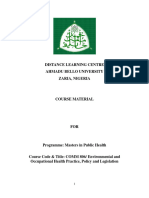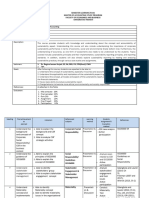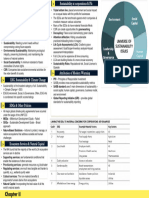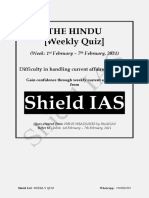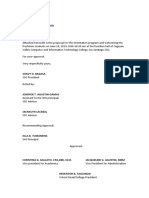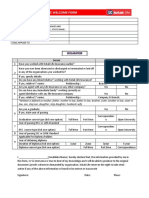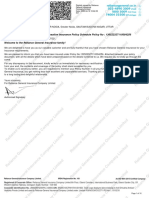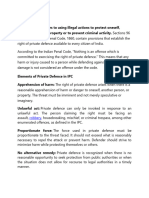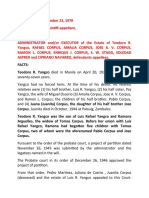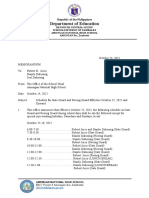Contenido
Introduction ........................................................................................................................................... 3
Course Learning Objectives .................................................................................................................. 4
Stage 1: Fundamentals of Social and Environmental Compliance Inspections (SECI) ................. 4
Stage 2: Module Learning Goals ....................................................................................................... 7
Stage 3: Module Learning Goals ....................................................................................................... 9
Course Format ..................................................................................................................................... 10
Target Audience ............................................................................................................................... 10
Prerequisites and Course Requirements ....................................................................................... 10
Pace ................................................................................................................................................... 10
Structure ........................................................................................................................................... 11
Activities ............................................................................................................................................ 11
Technical Assistance and Instructional Resources ........................................................................ 11
Page 1 of 15
�Assessment and Certification ............................................................................................................. 12
Placement test .................................................................................................................................. 12
Quizzes and Stage Tests .................................................................................................................. 12
Course Certificates ........................................................................................................................... 13
Digital Badges ................................................................................................................................... 13
Course Policies ..................................................................................................................................... 14
Privacy Policy .................................................................................................................................... 14
Accessibility Policy ............................................................................................................................ 14
Academic Integrity Policy................................................................................................................. 14
Communication Policy ..................................................................................................................... 14
Course Team ........................................................................................................................................ 14
Content ............................................................................................................................................. 14
Design and Development ................................................................................................................ 15
Copyright Information ......................................................................................................................... 15
Page 2 of 15
�Introduction
Welcome to the course on Social and Environmental Compliance Inspections (SECI)!
One of our main objectives at the Inter-American Development Bank (IDB) is to promote the
strengthening of the national environmental and social licensing and control systems that help
countries achieve a healthy balance between economic growth and preservation of the natural
environment. These national systems are constantly developing and evolving; they are also
complex and diverse, reflecting each country’s different environmental, socioeconomic, and
cultural realities and priorities.
To help projects comply with its regulations, the IDB has identified a series of common sequential
stages within "project cycles" that have been incorporated into this training. This three-stage
training course (Figure 1) provides current and future inspectors with the fundamental knowledge
for planning and conducting inspections, as well as detailed guidance for carrying out on-site and
post-inspection activities.
1. Fundamentals
of social and 3. Post-SECI
2. Planning and
environmental inspection
conducting SECI
compliance activities
inspections (SECI)
Figure 1. Stages of the Social and Environmental Compliance Inspections (SECI) Course
With this on-demand, online course, you can receive training that will help you conduct your
inspections more effectively and efficiently, resulting in improved compliance and enforcement.
As the course is self-paced, you can take the training at any time and in any place. It is possible to
test out of a stage by taking a pre-course test (see Assessment and Certification, later in this
guide). The overall duration of the course is around 22 hours.
Page 3 of 15
�Course Learning Objectives
General learning objectives of the SECI course are to:
1. Identify the principles, roles, and responsibilities required for environmental and social
inspection according to international good practices.
2. Explain why environmental and social compliance inspections are necessary to ensure
regulation and law enforcement.
3. Manage resources efficiently through targeted compliance promotion, compliance
monitoring, inspections, and enforcement activities.
4. Identify the inspection functions necessary to effectively manage environmental and social
risks and impacts and the appropriate responses to violations.
5. Identify the elements of an enforceable requirement.
6. Select inspection and monitoring activities to ensure compliance within a regulatory
framework.
7. Identify ways in which to collect, document, and present evidence, including samples, in a
legally defensible manner.
Next are the module learning objectives and duration for each stage.
Stage 1: Fundamentals of Social and Environmental Compliance Inspections (SECI)
Stage Duration: 7.5 hours
In this stage of the SECI course, you will explore the basic definitions, concepts, roles, and
frameworks of an inspection, such as the different types and goals of compliance and
enforcement, criteria for targeting and prioritizing inspections, the role of inspectors, enforcing
requirements, and collecting defensible evidence.
Page 4 of 15
�Module 1 – Introduction to Social and Environmental Compliance Inspections (SECI)
1. List motivations or incentives for compliance and their impact on improved environmental
and social management.
2. Identify types of enforcement and compliance and how to incentivize it.
3. Recognize what is enforcement, the goal of enforcement, and how to use it to increase
compliance.
4. Identify the components of an effective compliance and enforcement program and how to
use them as a tool for deterrence.
5. Describe the possible results and the processes that are initiated when non-compliance is
identified for an inspected site, facility, or project.
6. Identify the advantages of using enforcement as deterrence and to ensure compliance.
7. Recall the social issues to consider during an enforcement process.
8. Recognize systems of promoting accountability, including defining compliance and
enforcement or deterrence strategies resulting from inspections.
Module 2 – Targeting and Prioritization
1. Recall the difference between environmental and social risks and impacts.
2. Identify various rationale for conducting an inspection.
3. List the criteria for targeting and prioritizing facility inspections.
4. Describe environmental justice and equity and how inspections can help address the issue
and prevent the materialization of a risk.
Module 3 – The Inspector and Inspections
1. Distinguish the inspector roles within the inspection process and the importance of
relationships of the inspector with the inspection team and the activities, facilities, projects,
and people inspected for realizing successful enforcement.
2. Differentiate the types of inspections according to the motivations for the inspection.
Page 5 of 15
� 3. Assess the role of company compliance auditing and certification with international
standards.
4. Recognize ethical considerations in the inspection process and the steps to prevent the
appearance of unethical behavior or bribery.
5. Describe the responsibilities of inspection team members.
6. Identify the types of confidential business information and their implications.
7. Recognize the importance of the Inspector’s authority and its influence on the inspection
process.
Module 4 – Enforceable Requirements
1. Differentiate the three types of standards, according to their requirements.
2. Translate requirements into verifiable items that can be used as elements of proof.
3. Evaluate how to approach an inspection according to the requirements to be met.
4. Describe the elements of an enforceable requirements and a motivation for compliance.
5. Identify ways to more easily enforce a requirement and make recommendations to
regulators to improve enforceability of requirements.
Module 5 – Defensible Evidence
1. Describe the rationale behind collecting defensible evidence and ensuring its admissibility
in a court proceeding.
2. Recognize what evidence is and the different types of evidence.
3. Indicate the value of instruments’ verification and documentation.
4. Recall how to handle evidence properly, including maintaining the chain of custody.
5. Underline the importance of maintaining good and consistent habits and procedures while
planning and performing inspections.
6. Distinguish how evidence collected by citizens can be used and needs to be treated.
Page 6 of 15
� 7. Acknowledge the role community science and monitoring could play in supporting
government compliance and enforcement programs.
Stage 2: Module Learning Goals
Duration: 7.5 hours
During this stage, you will learn how to plan an inspection, perform onsite activities, collect
samples, and identify laboratory issues, and conduct inspection interviews.
Module 1 – Planning an Inspection
1. Recognize the importance of planning and preparation when conducting inspections.
2. Recall the elements of a complete inspection and project plan, including all necessary
elements for complex inspections.
3. List the documents that should be reviewed to prepare for an inspection that will gather
the most information before the visit.
4. Recognize the relevance of health and safety planning in inspections for the inspector, the
facility, and the community.
5. Underline the benefits of identifying facility and inspection stakeholders and inform them
of all events that might concern them.
6. Explain regulation and regulatory governance and provide concrete examples.
Module 2 – Performing Onsite Activities
1. Identify access granted vs access denied, the steps for gaining access to the facility for
inspection, and what to do if access is denied.
2. Describe what to expect from each step of the site visit.
3. State how to perform a site visit to ensure all inspection objectives are fulfilled.
4. List issues to inspect to ensure that gender and labor considerations have been addressed.
Page 7 of 15
� 5. Describe what to expect from the closing conference and the preliminary Discussion of
Findings.
6. Recognize the value of credentials to demonstrate the inspector’s authority and capacity to
adequately inspect.
7. Explain regulation and regulatory governance and provide concrete examples.
Module 3 – Collecting Samples and Identifying Laboratory Issues
1. Identify what is a sample, reasons to collect samples, and uses in defending a case.
2. Recall the difference between representative and random samples.
3. Recognize the importance of collecting representative samples, and how to ensure and
demonstrate that samples are representative.
4. Outline the elements of a sampling plan, the importance of adhering to one, and when to
deviate from the plan, including samples of opportunity.
5. List the details to convey to the laboratory to ensure quality of results, including types of
control samples.
6. Recall the use of certifications and calibrations to ensure good quality and accuracy of data.
7. Identify common sampling errors and how to avoid them.
8. Recognize different sampling equipment and its use in the field during an inspection.
Module 4 – Conducting Interviews
1. Identify the four modes of communication.
2. Describe communication barriers, how they occur, and how to avoid them.
3. Outline the components and steps for a successful interview, including social and individual
considerations of an interviewee to effectively encourage confessions.
4. Describe proxemics and identify how to use proxemics, location, and timing for a
successful interview.
Page 8 of 15
� 5. Recognize how to ask questions correctly to gather quality answers and the questions to
avoid during an interview.
6. Recall the requirements to record and document interviews to ensure records are as
accurate as possible.
Stage 3: Module Learning Goals
Duration: 4.5 hours
In Stage 3, you will review the critical activities in documenting inspections and managing the
enforcement process.
Module 1 – Documenting Inspections
1. Recognize the importance of documenting inspections with quality Inspection reports that
are factual, complete, and accurate.
2. Identify different methods for writing an effective inspection report and ensuring all
gathered information is available.
3. Distinguish the different sections of a typical inspection report, their objective, and their
content.
4. Remember tips for writing an effective inspection report, taking into consideration the
audience and the specific style needed for the report to be a relevant piece of evidence.
5. Recall the advantages of documenting inspections with pictures, as well as the methods for
recording details to ensure pictures are usable as proof.
6. State the need for integrating observations of facility operations and practices using
regulatory citations.
7. Outline the uses and applications of electronic inspection recording devices.
Module 2 – Managing the Enforcement Process
1. Outline the basic principles of the enforcement process.
Page 9 of 15
� 2. Identify reasons why enforcement is needed and how to proceed with enforcement in a
case of environmental or social violation.
3. Recognize the factors governing penalties and the different systems for calculating them.
4. Remember the implications of being a witness and tips for being an effective one.
5. Recall the pros and cons of settlements vs taking a case to court, and the biggest obstacles
to reaching a settlement.
6. Identify the situations in which an inspector needs to negotiate, different negotiation tips,
what to avoid, and resolution strategies.
7. Name ways in which informing the public can advance deterrence.
Course Format
Target Audience
The target audience for this course are inspectors who work as part of an inspection project team
within their respective Ministries of the Environment. Inspectors may or may not have previous
inspection experience or environmental/social training; their experience level can range from new
inspectors to experienced inspectors (e.g., 20+ years). Inspectors can include both environmental
and social specialists.
Prerequisites and Course Requirements
There are no prerequisites for previous knowledge or required competencies to participate in this
course. An intermediate level of English proficiency is preferred, and you should also have an
available time commitment of about 2 hours per module.
Pace
This is a self-paced course, which means you have the freedom to complete the course stages at
your own pace. You should try to complete course stages within the calendar year in which you
have begun the course.
Page 10 of 15
�If you complete a stage of the course but not the entire course within the calendar year, you can
receive a stage pass that can be carried over to the next year. This allows you to start a
subsequent stage in following editions. For example, you begin the course in July 2024; in
December 2024, you have successfully completed Stage 1 of the course. You will receive a stage
pass for completing the remaining stages in the next year(s).
Note: You will not receive a pass for an incomplete stage; if you
don’t finish a stage before the course ends, you will need to
restart an incomplete stage from the beginning.
As this is a self-paced course, you will not be interacting with an instructor or other participants,
and you will complete the course at your own speed. The course activities are designed for you to
consider in the context of your own country or region and then transfer your learning to the
workplace.
Structure
The SECI course consists of three stages, and each stage contains modules, which are structured
in a similar way. Each module focuses on a specific SECI topic and includes interactive
presentations, questions for reflection, and quizzes.
Activities
The course includes online discussion forums and quizzes. The discussion forums are spaces
within the online classroom for written responses to questions for reflection. Quizzes consist of
multiple-choice questions that check your knowledge upon module completion.
Technical Assistance and Instructional Resources
Within the online course, the following technical assistance and instructional resources are
available to facilitate your learning process:
Page 11 of 15
� • INDES HELP: If you wish to contact INDES for any information related to the navigation
and content of the course, or for technical help, you can do so using this tool.
• Learning Guide: You will use this guide to help navigate you navigate through your
learning experience. We encourage you to download the guide and keep a copy close by.
• Instructional resources: Resources available in the course modules include interactive
media presentations, web pages, and sample documents and checklists.
Assessment and Certification
Placement test
If you have the requisite knowledge of the content presented in the stage modules, you will have
the option to test out of a stage. To successfully test out of a stage, simply complete the
placement test for the stage; you must have a 90% pass rate on the stage placement test.
Please note that you will be required to take the placement test before beginning the stage. You
will have only one opportunity to successfully pass the test for each stage.
Quizzes and Stage Tests
After completing a stage of the course, you will complete a Stage test. You will need a 70% pass
rate on the stage test to successfully pass the Stage. You will have two opportunities to
successfully pass the stage test.
To assess your progress toward meeting stage and module learning goals, each module includes a
quiz at the end of the module. You will be given two opportunities to successfully answer a quiz
question. There are also reflective activities in each module to help you prepare for the quiz
content.
Page 12 of 15
�While completing the quiz, incorrect answers will be shown for each module question, and
feedback will be provided for each incorrect question response. To successfully complete a stage,
you must have a combined pass rate of at least 70% for the module quizzes and stage test. The
average of the module quiz scores, and the stage quiz test score is determined according to this
table:
Value
Average of module quiz scores 75%
Stage test score 25%
Course Certificates
To successfully complete a stage, you must pass the module quizzes and the stage test with an
average 70% pass rate. Once you have successfully completed a stage, you will receive a
certificate; upon successfully completing all three stages of the course (70% pass rate), you will
receive a course certificate.
Digital Badges
To successfully complete a course stage, you must have at least a 70% score on module quizzes
and stage test (average). Upon successful completion, INDES will issue you a digital badge, as well
as a stage pass, as evidence of your accomplishment.
You will also receive a course digital badge upon successfully completing all three stages and the
post-course test. You can share your digital badges on your social media accounts and in your
digital portfolio. You will receive instructions for downloading your badges and stage passes in an
email (sent to the email account you used to register for the course).
Page 13 of 15
�Course Policies
You are responsible for your own training process and progress, and it is your duty to review and
know the policies that govern this course. Therefore, we invite you to review the policies by which
the INDES courses are framed, which are briefly described here:
Privacy Policy
This policy describes issues related to confidentiality and the use of your personal information
and data.
Accessibility Policy
This policy refers to providing accessible content to people with disabilities.
Academic Integrity Policy
This policy explains the foundations of academic integrity and the actions that will be taken when
specific cases of plagiarism or academic dishonesty are detected.
Communication Policy
This policy outlines the netiquette and communication expectations you are expected to follow
when posting to the discussion forums in the course.
Course Team
Content
• Lara Chinarro, ESG Online Learning Program Manager (IDB).
The team thanks LeRoy Paddock (INECE), Aryel Abramovitz (EPA) and Amy Porter (EPA) for their
contributions and comments to improve the overall quality of the course.
Page 14 of 15
�Design and Development
• Stella Porto, Course Project Supervisor (Knowledge, Innovation and Communication Sector-
IDB).
• Mariano D’Angelo, E-learning Project Manager (Knowledge, Innovation and Communication
Sector-IDB).
• Andrea Attis Beltran, Consultant, (Knowledge, Innovation and Communication Sector-IDB)
• Lisa Marie Blaschke, Instructional Designer.
Copyright Information
Copyright © 2024. Inter-American Development Bank. This publication is subject to a Creative
Commons Attribution-Noncommercial-NoDerivs license (CG-IGO 3.0 BY-NC-ND) Creative
Commons Attribution-Noncommercial-NoDerivs IGO 3.0 license (CC-IGO BY-NC-ND 3.0 IGO)
(http://creativecommons.org/licenses/by-nc-nd/3.0/igo/legalcode) and may be reproduced for any
non-commercial use providing recognition is given to the IDB. Derivative works are not permitted.
Any dispute related to the use of IDB publications which cannot be resolved amicably shall be
subject to arbitration in compliance with UNCITRAL rules. The use of the IDB’s name for any
purpose other than respective recognition and the use of IDB’s logo are not authorized by this CC-
IGO license and require an additional licensing agreement.
Please note that the URL link includes additional terms and conditions of this license.
Page 15 of 15










